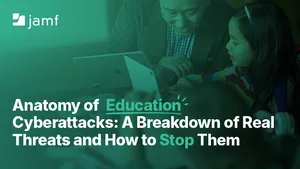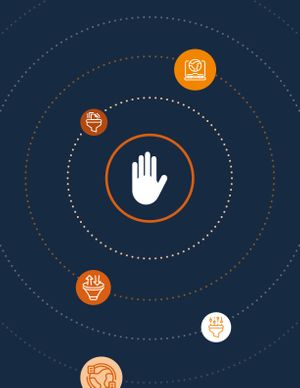From Reactive to Proactive: A Smarter Way to Manage School Cybersecurity
Discover how shifting from reactive responses to proactive strategies reduces risk and mitigate threats impacting K-12 schools globally.
Introduction
The education sector is no stranger to cybersecurity threats.
Because of continued attacks by threat actors, education is cemented among the top 10, highest-targeted global industries, based upon the distribution of cyberattacks in 2024.
Despite education as an industry appearing lower in the rankings, the appeal for threat actors’ mirrors that of similarly targeted industries also on the list, thanks to its:
- Cache of student and confidential data
- Propensity for large-scale disruptions
- Substantial ransom payments
These similarities, alongside a brief breakdown of some of the most immediate (and mitigatable) threats impacting Edu, anchor our theme of being proactive versus reactive. Also in this blog, we answer the question of why this important distinction is essential for Edu.
Is it better to safeguard valuable resources before sophisticated threats occur or in response to a breach?
5 critical threats affecting Edu
While far from an exhaustive list of security threats impacting K-12 schools, the aim here is to summarize the most critical threats used to successfully compromise institutional devices, data and the networks they communicate through. Understanding these threats, and how they’re leveraged, is a precursor to confidently implementing proactive strategies that mitigate risk instead of scrambling to contain an incident in reaction to a breach.
Note: The statistics and percentages cited in this section are derived from the Verizon 2025 Data Breach Investigations Report.
Malware
A top attack pattern for the third year in a row, according to Verizon, malware and its assorted variants pose the single greatest risk to educational services continuity.
How bad is it?
Malware was utilized by threat actors in 42% of Edu breaches. The most common type, ransomware (30%), impacts schools in the following ways:
- Disrupts educational services and affects student outcomes
- Leaks confidential data, impacting legal liability and public trust
- Costs districts millions of dollars in containment and fees
Insider threats
Regardless of motives – unintentionally exposing data (8% of cases result from misuse) or deliberately abusing privileges to exfiltrate data (99% of misuse cases involved abusing permissions) – amplifies risk, thereby harming schools. With 38% of breaches found to involve internal threat actors.
Insider threats impact schools in the following ways:
- Sharing data with the unauthorized personnel jeopardizes compliance
- Minimizes the district’s ability to negotiate contracts with partners
- Stakeholders face greater risk to current/future attacks from leaked data
Misconfigurations
Errors stemming from misconfigurations have been on an upward trend over the last three years. Found in 29% of breaches, misconfigurations also reinforce risks from other threats, like granting unnecessary permissions or reducing protections against further compromise.
Examples of how misconfigurations impact schools are:
- Threat actors can easily defeat default settings/passwords to extend attacks across school networks
- Stakeholders must focus on fixing tech issues instead of facilitating educational outcomes
- Increased IT management overhead results from a lack of device standardization
Vulnerabilities
Vulnerabilities fall under the umbrella of system intrusion, whereby threat actors locate and exploit weaknesses within hardware, software and/or identity workflows to obtain access.
Patching apps is a critical security strategy, but why’s identity included as a vulnerability?
Nearly a quarter (24%) of threats used stolen credentials to impact schools by:
- Gathering and exfiltrating sensitive personal and school data
- Disrupting access to learning tools, like computers and cloud services
- Further compromising district networks, resulting in loss of use and/or damages
Social engineering
Social engineering is often employed by threat actors as an initial attack or as a step toward a deeper intrusion.
How often?
16% of breaches included a social engineering component, with 77% of which coming from the most common method: phishing.
Some of the ways social engineering impacts schools are:
- Abuses trust to deploy malicious code unbeknownst to the victim
- Harvests valid credentials by mirroring real-world password reset scenarios
- Gathers information to be used in sophisticated attacks against high-value targets
Proactive > Reactive
“Most people assume that once security software is installed, they're protected. This isn't the case. It's critical that companies be proactive in thinking about security on a long-term basis.” – Kevin Mitnick
For IT and districts alike, the job may feel like an uphill climb. While schools focus on educating the future, IT is tasked with securing it. Both face obstacles that threaten progress, including:
- Limited financial resources
- Outdated hardware and software
- Overburdened employees
These challenges compound the technical threats discussed earlier. And while it’s beyond this blog’s scope to address all challenges in detail, the solutions outlined below highlight a broader strategy: shifting IT mindsets from a reactive approach to a proactive one – prioritizing risk mitigation and threat prevention over incident response and endpoint remediation.
Standardize configurations with baselines
Misconfigurations often occur when settings are not secured by IT. Addressing this risk requires two steps:
- Deploying configuration profiles that meet institutional needs
- Enforcing them to prevent changes – whether intentional or not.
Standardization is key, involving central deployment and maintenance of hardened configurations on endpoints so they consistently meet compliance. Baselines support this process by providing flexible yet structured criteria to guide endpoint configuration.
Compliance levels that build upon each other can be established across managed devices, such as mandating multifactor authentication and integration with cloud-based identity providers for all endpoints. From there, requirements can expand, like ensuring passcodes that enable volume encryption are required for schools using iPads to keep sensitive content stored on them secure.
Automate patch management processes
According to Jamf Threat Labs, “32% of organizations operate at least one device with critical (and patchable) vulnerabilities.” Industry estimates state that 60% of data breaches could have been prevented with available patches.
Simply put: Vulnerabilities represent a major threat vector that is largely preventable with patch management processes.
The keys to effective application lifecycle management are deploying patches:
- Consistently
- Efficiently
- Automatically
Automated patching delivers OS, first-/third-party application updates and security fixes as soon as developers release them. It ensures patches are applied across device fleets, while active monitoring provides visibility into update statuses. By automating this repetitive task, IT teams are freed to focus their skills on higher-value efforts, like improving the learning environment for students, teachers and staff.
AI-based protection and active endpoint monitoring
AI, Machine Learning (ML) and Large-Language Models (LLMs) are at the forefront of Education. From discovering ways to enrich equitable student learning to streamlining toolsets used by teachers to deliver engaging lessons – schools expanding EdTech tooling with AI are simultaneously expanding their attack surface in the process.
Like the Chinese principle of “Yi du gong du” – fighting poison with poison. It is crucial for school districts to embed AI/ML-based defenses within their security strategy to enable detection and mitigation of the accelerated risks stemming from threat actors leveraging AI to develop sophisticated threats.
Combined with active endpoint monitoring, IT capabilities are supercharged by:
- Personalized security recommendations
- Faster, more accurate threat detection
- Automated incident response
- Prioritized vulnerability management
- Scalable, holistic protections
Integrate identity and access management (IAM) workflows
With commonly used applications operating more like cloud-based services and the continued utilization of mobile devices as learning tools for both school and home, identity-based attacks have grown into a top threat for Education.
GenAI-based improvements make social engineering campaigns more believable while sophisticated attacks compromise school networks by targeting gaps in the security stack, IAM is as much a foundational component of Edu cybersecurity strategies, as device management and endpoint security.
Much like how management and security have converged, identity is added to that convergence, steering dynamic security across modern infrastructures in fundamental ways:
- Contextual, risk-based authentication
- Adaptive controls maintain compliance
- Continuous verification of health telemetry
- Micro-segmentation and network isolation
- Enhanced, secure remote access
Enforce compliance through policies and benchmarks
Compliance is fleeting. It’s a constantly moving target.
Where baselines help schools to know they were compliant during device provisioning and deployment; monitoring provides insight into device health statuses at any given time. But benchmarks give IT a means to compare baselines and current statuses to industry best practices to answer the question, are we compliant today?
Maintaining compliance requires more than achieving it once.
Updates, apps, configurations and threats all introduce changes to hardware and software, making compliance not just a destination, but a path. Implementing compliance benchmarks help institutions to proactively:
- Optimize security postures
- Adhere to standards and frameworks
- Identify areas of improvement
- Improve incident response
- Track progress over time
- Enforce regulatory compliance
- Maximize ROI and minimize TCO
Conclusion
Cybersecurity in education is a shared responsibility – it’s one that extends beyond IT teams to each stakeholder who relies on secure devices to learn, teach and lead.
The threats outlined in this blog make clear that the sector remains a prime target because of its sensitive data, potential for disruption and financial incentives for threat actors.
While tools like baselines, automated patching, AI-driven defenses, identity workflows and compliance benchmarks strengthen security, their efficacy derives from a proactive mindset. Shifting from a reactive approach to one centered on risk mitigation and threat prevention allows schools to eliminate threats before they escalate into costly breaches.
To be clear, a complete security plan includes incident response and endpoint remediation alongside them.
No strategy is completely impervious.
However, proactive practices ensure schools are better positioned by prioritizing data safeguards, maintaining compliance, minimizing disruptions and supporting their mission of education without being defined by crises.
Key takeaways
- Education ranks among the top 10 most-targeted global industries.
- Malware, misconfigurations, insider threats, vulnerabilities and social engineering dominate school breaches.
- Malware alone accounts for 42% of breaches; ransomware drives 30%.
- Automation, patch management, compliance benchmarks and monitoring reduce IT workload while closing security gaps.
- Identity and AI-based defenses are essential.
- Prevention beats reaction: 60% of breaches could have been stopped with patches.
Simplify your approach with proactive strategies, like automation and compliance benchmarks today.


